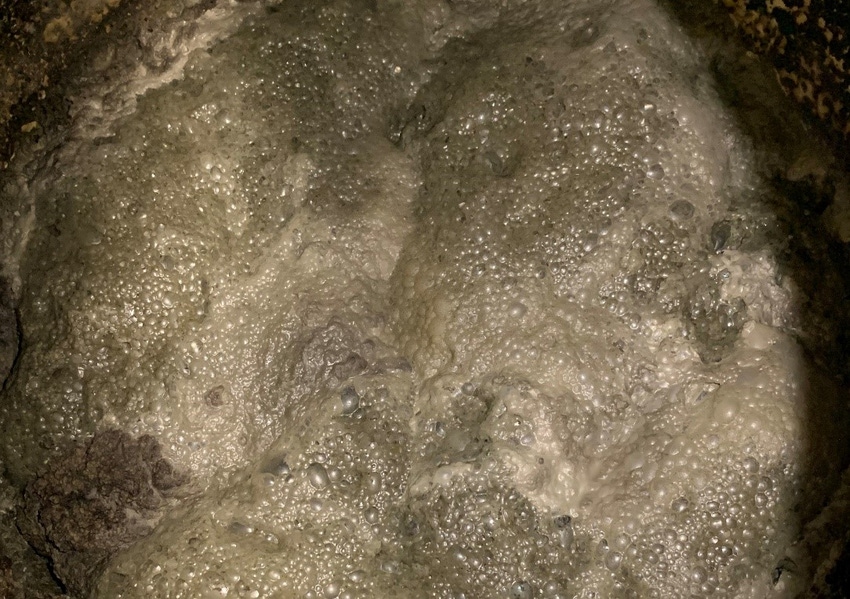Research tests marketed products for efficacy in mitigating emissions of targeted gases.
February 2, 2021

The United States is one of the top 3 pork producting countries in the world. While the pork industry stimulates the economy and generates jobs, it also generates odor and gaseous emissions potentially affecting the air quality in surrounding communities.
Manure additives are marketed to mitigate odor and emissions. They are easy to apply to manure (e.g., periodically poured into the manure pit) without changing the current storage structures. To date, however, there was very little scientific data on how these marketed products perform in mitigating gaseous emissions from swine manure. The last major odor product comparison study was carried out over two decades ago, and new products have been introduced since then.
Dr. Koziel and his team at Iowa State University tested 12 marketed products for their efficacy in mitigating emissions of targeted gases (odor, odorous volatile organic compounds (VOCs), hydrogen sulfide (H2S), ammonia (NH3), greenhouse gases (GHGs)) (Chen et al., 2020a; 2020b; Koziel et al., 2020). The products tested were Confine, Enviro Lagoon, LLMO-SST, Manure Magic, Manure Master Plus, More Than Manure, Oxydol, Penergetic G, Sulfi-Doxx dry, Sludge Away, Triune and Waste Away. The team used recommended dosages from the products' labels and a pilot-scale system simulating eight-week long manure storage in a deep-pit system. Manure was outsourced from three swine farms to represent a variety of manure storage types and other factors affecting the properties. Measured gaseous emissions were compared between the treated and untreated manure.
The results were not statistically significant compared with untreated manure for all 12 products tested. None of the tested products stastically mitigated emissions of odor, NH3, H2S, GHGs, and odorous VOCs from stored swine manure. The results of this study do not warrant full-scale trials with the tested products.
This project was funded by the National Pork Board and Indiana Pork Producers Association to fulfill the needs of farmers and the regulatory community with scientific data on the performance of marketed manure additives that are available to the U.S. Midwest pork industry.
In other related research, Dr. Koziel's team developed and tested other experimental manure additives such as soybean hulls and biochar, both of which showed significant odor and gas emissions mitigation effects. For example, a thin (0.25 inch thick) layer of biochar applied surficially to manure successfully mitigated approximately 40% NH3, 20% H2S, 90% p-cresol, and 70% skatole emissions (Meiirkhanuly et al., 2020a; 2020b) on a lab-scale evaluation. Volatile organic compounds (VOCs) such as p-cresol are responsible for the characteristic “barnyard” odor downwind.
Follow-up work on a pilot-scale biochar application resulted in 30% NH3 and 42% skatole emissions reduction, with mitigation significantly enhanced with the bi-weekly reapplication of biochar (Chen et al., 2021). In addition, biochar reduced up to 80% of total H2S emissions during the swine manure agitation and pump-out in lab-scale trials (Chen et al., 2020c).
The application of soybean peroxidase on a pilot-scale study showed ~80% reduction on dimethyl disulfide, ~90% on p-cresol, ~90% on skatole, ~ 65% on NH3, and increased methane production (Maurer et al., 2017a). The farm-scale trials showed approximately 20% reduction in NH3, 80% reduction in H2S, and 30% to 40% reduction in odorous VOCs (Maurer et al., 2017b).
Sources: Jacek Koziel, Baitong Chen, Daniel Andersen, David Parker, Andrzej Bialowiec, Chumki Banik, Myeongseong Lee, Samuel O'Brien, Hantian Ma, Zhanibek Meiirkhanuly, Jisoo Wi, Peiyang Li, Iowa State University, are solely responsible for the information provided, and wholly own the information. Informa Business Media and all its subsidiaries are not responsible for any of the content contained in this information asset.
References
Chen, B., J.A. Koziel, C. Banik, H. Ma, M. Lee, J. Wi, Z. Meiirkhanuly, S.C. O'Brien, P. Li, D.S. Andersen, A. Białowiec, D.B. Parker. 2020a. Mitigation of odor, NH3, H2S, GHG, and VOC emissions with current products for use in deep-pit swine manure storage structures. Frontiers in Environmental Science, 8, doi: https://doi.org/10.3389/fenvs.2020.613646
Chen, B., J.A. Koziel, C. Banik, H. Ma, M. Lee, J. Wi, Z. Meiirkhanuly, D. Andersen, A. Białowiec, D. Parker. 2020b. Emissions from swine manure treated with current products for mitigation of odors and reduction of NH3, H2S, VOC, and GHG emissions. Data, 5(2), 54; doi: https://doi.org/10.3390/data5020054.
Chen, B.; Koziel, J.A.; Banik, C.; Ma, H.; Lee, M.; O'Brien, S.C.; Li, P.; Andersen, D.S.; Białowiec, A.; Brown, R.C. (2021) Mitigation of Gaseous Emissions from Stored Swine Manure with Biochar: Effect of Dose and Reapplication on a Pilot-Scale. Atmosphere, 12, 96. https://doi.org/10.3390/atmos12010096
Chen, B., J.A. Koziel, A. Bialowiec, M. Lee, H. Ma, Z. Meiirkhanuly, P. Li, R.C. Brown. 2020c. The impact of surficial biochar treatment on acute H2S emissions during swine manure agitation before pump-out: proof-of-the-concept. Catalysts, 10(8), 940; doi: https://doi.org/10.3390/catal10080940
Koziel, J.A., D. S. Andersen, D.B. Parker, B. Chen. Evaluation of current products for use in deep-pit swine manure storage structures for mitigation of odors and reduction of NH3, H2S, and VOC emissions from stored swine manure. National Pork Board. Project 17-158. Final Report, April, 2020.
Meiirkhanuly, Z., J.A. Koziel, A. Bialowiec, C. Banik, B. Chen, M. Lee, J. Wi, R.C. Brown, S. Bakshi. 2020a. Mitigation of gaseous emissions from swine manure with the surficial application of biochar, Atmosphere, 11(11), 1179; https://doi.org/10.3390/atmos11111179.
Meiirkhanuly, Z., J.A. Koziel, A. Bialowiec, C. Banik, R.C. Brown. 2020b. The proof-of-the concept of biochar floating cover influence on swine manure pH: implications for mitigation of gaseous emissions from area sources, Frontiers in Chemistry, 8, 656; doi: https://doi.org/10.3389/fchem.2020.00656.
Maurer, D.L., Koziel, J.A., Bruning, K., and Parker, D.B. 2017a. Pilot-scale testing of renewable biocatalyst for swine manure treatment and mitigation of odorous VOCs, ammonia and hydrogen sulfide emissions. Atmospheric Environment, 150, 313-321. https://doi.org/10.1016/j.atmosenv.2016.11.021
Maurer, D., J.A. Koziel, K. Bruning, D.B. Parker. 2017b. Farm-scale testing of soybean peroxidase and calcium peroxide for surficial swine manure treatment and mitigation of odorous VOCs, ammonia, hydrogen sulfide emissions. Atmospheric Environment, 166, 467-478. doi: https://doi.org/10.1016/j.atmosenv.2017.07.048.
You May Also Like



